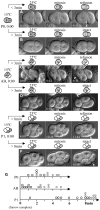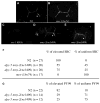NMY-2 maintains cellular asymmetry and cell boundaries, and promotes a SRC-dependent asymmetric cell division
- PMID: 20059995
- PMCID: PMC2903000
- DOI: 10.1016/j.ydbio.2009.12.041
NMY-2 maintains cellular asymmetry and cell boundaries, and promotes a SRC-dependent asymmetric cell division
Abstract
The nonmuscle myosin II NMY-2 is required for cytokinesis as well as for the establishment of zygote asymmetry during embryogenesis in Caenorhabditis elegans. Here we describe two conditional nmy-2 alleles that rapidly and reversibly inactivate the protein. We show that NMY-2 has late-cell-cycle roles in maintaining embryonic asymmetries and is also required for a surprisingly late step in the maintenance of the cytokinesis furrow. Finally, during a signaling-induced asymmetric cell division, NMY-2 is required for SRC-dependent phosphotyrosine signaling and acts in parallel with WNT-signaling to specify endoderm.
Copyright 2010 Elsevier Inc. All rights reserved.
Figures






Similar articles
-
The Caenorhabditis elegans nonmuscle myosin genes nmy-1 and nmy-2 function as redundant components of the let-502/Rho-binding kinase and mel-11/myosin phosphatase pathway during embryonic morphogenesis.Development. 2003 Dec;130(23):5695-704. doi: 10.1242/dev.00807. Epub 2003 Oct 1. Development. 2003. PMID: 14522875
-
Conditional nmy-1 and nmy-2 alleles establish that nonmuscle myosins are required for late Caenorhabditis elegans embryonic elongation.Genetics. 2024 Sep 4;228(1):iyae109. doi: 10.1093/genetics/iyae109. Genetics. 2024. PMID: 39053622
-
PAR proteins regulate maintenance-phase myosin dynamics during Caenorhabditis elegans zygote polarization.Mol Biol Cell. 2017 Aug 1;28(16):2220-2231. doi: 10.1091/mbc.E16-04-0263. Epub 2017 Jun 14. Mol Biol Cell. 2017. PMID: 28615321 Free PMC article.
-
Going with the flow: insights from Caenorhabditis elegans zygote polarization.Philos Trans R Soc Lond B Biol Sci. 2020 Oct 12;375(1809):20190555. doi: 10.1098/rstb.2019.0555. Epub 2020 Aug 24. Philos Trans R Soc Lond B Biol Sci. 2020. PMID: 32829680 Free PMC article. Review.
-
Asymmetric Cell Division in the One-Cell C. elegans Embryo: Multiple Steps to Generate Cell Size Asymmetry.Results Probl Cell Differ. 2017;61:115-140. doi: 10.1007/978-3-319-53150-2_5. Results Probl Cell Differ. 2017. PMID: 28409302 Review.
Cited by
-
The interplay of stiffness and force anisotropies drives embryo elongation.Elife. 2017 Feb 15;6:e23866. doi: 10.7554/eLife.23866. Elife. 2017. PMID: 28181905 Free PMC article.
-
Internalization of multiple cells during C. elegans gastrulation depends on common cytoskeletal mechanisms but different cell polarity and cell fate regulators.Dev Biol. 2011 Feb 1;350(1):1-12. doi: 10.1016/j.ydbio.2010.09.012. Epub 2010 Sep 26. Dev Biol. 2011. PMID: 20875815 Free PMC article.
-
Cell-to-cell heterogeneity in cortical tension specifies curvature of contact surfaces in Caenorhabditis elegans embryos.PLoS One. 2012;7(1):e30224. doi: 10.1371/journal.pone.0030224. Epub 2012 Jan 10. PLoS One. 2012. PMID: 22253922 Free PMC article.
-
Wnt Signaling Induces Asymmetric Dynamics in the Actomyosin Cortex of the C. elegans Endomesodermal Precursor Cell.Front Cell Dev Biol. 2021 Sep 17;9:702741. doi: 10.3389/fcell.2021.702741. eCollection 2021. Front Cell Dev Biol. 2021. PMID: 34604213 Free PMC article.
-
NMY-2, TOE-2 and PIG-1 regulate Caenorhabditis elegans asymmetric cell divisions.PLoS One. 2024 May 24;19(5):e0304064. doi: 10.1371/journal.pone.0304064. eCollection 2024. PLoS One. 2024. PMID: 38787850 Free PMC article.
References
-
- Bei Y, Hogan J, Berkowitz LA, Soto M, Rocheleau CE, Pang KM, Collins J, Mello CC. SRC-1 and Wnt signaling act together to specify endoderm and to control cleavage orientation in early C. elegans embryos. Dev Cell. 2002;3(1):113–125. - PubMed
-
- Bjorge JD, Jakymiw A, Fujita DJ. Selected glimpses into the activation and function of Src kinase. Oncogene. 2000;19(49):5620–5635. - PubMed
-
- Bowerman B, Shelton CA. Cell polarity in the early Caenorhabditis elegans embryo. Curr Opin Genet Dev. 1999;9:390–395. - PubMed
-
- Boyd L, Guo S, Levitan D, Stinchcomb DT, Kemphues KJ. PAR-2 is asymmetrically distributed and promotes association of P granules and PAR-1 with the cortex in C. elegans embryos. Development. 1996;122:3075–3084. - PubMed
Publication types
MeSH terms
Substances
Grants and funding
LinkOut - more resources
Full Text Sources
Miscellaneous

